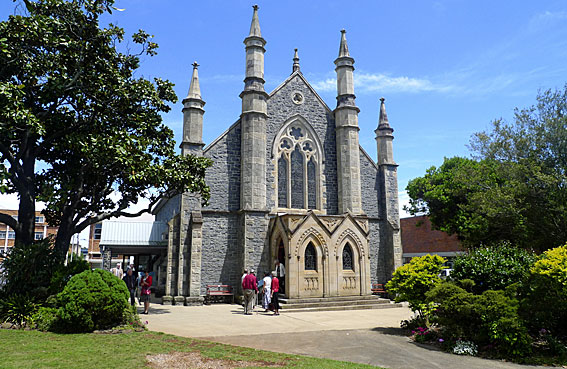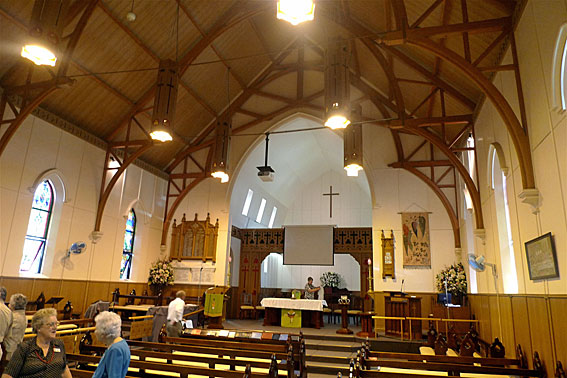
St Stephen's Uniting Church, Toowoomba
[Photograph by Trevor Bunning (November 2011)]

St Stephen's Uniting Church, Toowoomba
[Photograph by Trevor Bunning (November 2011)]
Historical and Technical Documentation by Geoffrey Cox
© OHTA 2011, 2013 (last updated May 2013)
There was a Presbyterian church in James Street in 1859, and the congregation of St Stephen's was formally constituted in 1863. The site of the present church in Neil Street was purchased in 1874, and the foundation stone of the new church building was laid in 1883. The building was opened in June 1884,1 having been designed by the prominent Toowoomba architect James Marks.2 The jubilee celebrations of the congregation in 1913 were marked by additions to the church and the installation of the pipe organ at a cost of £1,600.3
The organ was built by the Estey Organ Company of Brattleboro, Vermont, U.S.A, and comprised 7 speaking stops and 9 couplers with tubular-pneumatic action. The longest pipe of the Great Open Diapason was 6ft long, the bass pipes employing the ingenious Haskell patent for which the firm was noted.4 This was the only pipe organ by the Estey Organ Co. imported into Queensland, although several were imported shortly after this time for churches in New South Wales: The one for St Andrew's Presbyterian Church, Scone, NSW (1918) is very similar in appearance to the Toowoomba instrument, and only two stops larger.5
In conjunction with architectural renovations and new church furnishings at St Stephen's in 1966, the organ was rebuilt by H.W. Jarrott of Brisbane with electro-pneumatic action and the addition of two stops (Swell Oboe 8ft & Pedal Bass Flute 8ft). The organ console and the choir were moved at this time from their former position immediately in front of the organ.6 Two further stops (Great Principal 4ft & Fifteenth 2ft) were added in 1981 by Walter Emerson of Toowoomba.7

The position formerly occupied by the organ
in the apse at St Stephen's Uniting Church, Toowoomba
prior to the fire of January 1989
[Photograph by Trevor Bunning (November 2011)]
This organ was seriously damaged by fire in January 1989. The Swell pipework was relatively unharmed, but most of the pipework of the Great was melted and the console and soundboards suffered considerable water damage. The organ was subsequently removed.8
The specification was as follows:
| GREAT Open Diapason Melodia Dulciana Principal Fifteenth SWELL Stopped Diapason Salicional Harmonic Flute Oboe PEDAL Bourdon Bass Flute COUPLERS Great to Pedal Swell to Pedal Swell to Great Swell to Great 4' Swell to Great 16' Swell to Swell 4' Swell to Swell 16' Swell Unison Off Great Unison Off |
8 8 8 4 2 8 8 4 8 16 8 |
A A |
[1981] [1981] [re-named 'Lieblich Gedacht' in 1966] [1966] [1966] (reversible piston) (reversible piston) [replaced by Great Super in 1966] |
Swell tremulant
Electro-pneumatic action (formerly tubular-pneumatic)
Detached stop-key console
Balanced swell pedal
Compass: 61/25
Great to Pedal reversible toe piston.9
__________________________________________________________________
1 Richard Bardon, The Centenary History of The Presbyterian Church of Queensland (Brisbane: W. R. Smith & Paterson, 1949), pp. 258-59; "Diary of Events" for 1 June, 1884 in Pugh's Queensland Almanac for 1885.
2 Donald Watson & Judith McKay, Queensland Architects of the 19th Century: A Biographical Dictionary (Brisbane: Queensland Museum, 1994), pp. 121-22; The Queenslander (7 June 1884), p. 915.
3 St Stephen's Presbyterian Church Centenary 1863-1963 [privately printed, c.1963]; The Brisbane Courier (14 November 1913), p. 9.
4 Collected Organ Specifications of Bernie Brohan (c.1952) & Notebooks of Mr E.R. Salisbury (n.d.).
5 Graeme Rushworth, Historic Organs of New South Wales: The Instruments, Their Makers and Players 1791-1940 (Sydney: Hale & Iremonger, 1988), p. 236.
6 Dedication Service leaflet (27 November 1966), supplied by Rev. Neil E. Key, 1974; Personal communication from H.W. Jarrott to G. Cox, 1974.
7 Personal communications to G. Cox from Walter Emerson, undated.
8 OHTA News, vol. 13, no. 2 (April 1989), p. 5; Personal communication to G. Cox from Leslie W. Rub, October 1990.
9 Specification noted by G. Cox, February 1974, incorporating subsequent details as noted above.